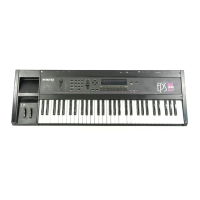EPS-16 PLUS Musician's Manual
Section 4 — Effects
Programming Effects
The EPS-16 PLUS effects are highly programmable. There are several effect
parameters for every effect type. The EFFECT/Select•Bypass page contains the
parameter for selecting which effect will be used. This page controls how all of
the other effect screens (found on the EDIT/Effects page) will be configured and
displayed. When this parameter is changed, a new effect is selected which causes
several important things to occur.
When a new effect is selected:
• a new effect is loaded, causing a brief pause in the audio output,
• the number of voices and the playback sample rate may change,
• the effect parameter screens are redefined for the particular effect selected, and
• the effect parameter values are reset to their default settings for the preset effect
The Effects Busses
The output of every voice in the EPS-16 PLUS is assigned to a stereo bus. A
bus, like the bus of a mixing board, mixes together all the voices assigned to that
bus into a single stereo pair. Of the four busses on the EPS-16 PLUS, three are
inputs into the signal processor (BUS1, BUS2, and BUS3), and the fourth is a
direct path to the AUX1 output that bypasses all effect processing (dry). The
Destination Bus assignment for each Wavesample is set in the EDIT/Amp page.
The voice settings in the sound can be over-ridden for each bank from the
EFFECT/Select•Bypass page.
Single Function Effect Mixer
The above illustration shows the effects busses and the output mixing. Every
voice is assigned to one of the four stereo busses, which go around or through
the effects processing. The heavy lines are stereo paths. Some effects, such as
HALL. REVERB also have a wet/dry mix of BUS3 into Effect 1.
Note: BUS 2 and BUS3 are "shared" by the internal effects architecture and the BUS 2
and BUS3 outputs. They can be removed from the internal effects path if
desired. See Section 2 — System Controls for more details.
Programming Effects
4 - 5

